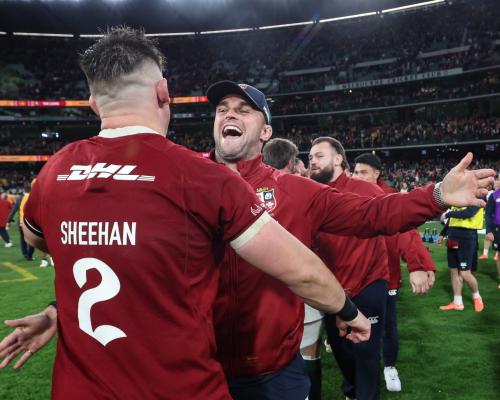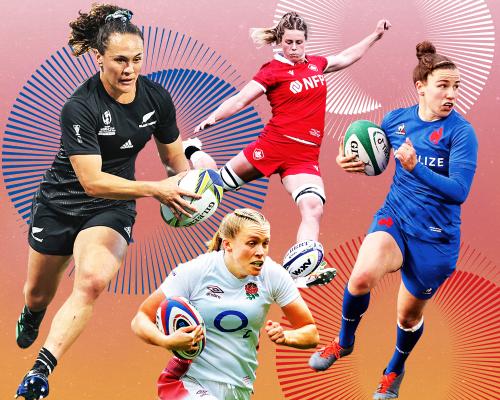
The average worker bee, in the busiest months of the year, generally lives for up to seven weeks. Talk about a short and sweet existence. It is not dissimilar with British & Irish Lions tours. One moment players are winning a major series, the next their team abruptly ceases to exist. That’s all, folks, unless you can make the next trip in four years.
That is a lifetime for many professional athletes, particularly those who routinely operate on a week-to-week basis and are about to enjoy a long-awaited summer break. So you would expect someone like England’s Ben Earl to roll his eyes and change the subject when asked if he would like to be involved in the scheduled next men’s tour to New Zealand in 2029.
Instead, the 27-year-old flanker sounded as if he would happily jump on a plane to Auckland tomorrow morning if asked. “If someone said to me I could go on the next one, I’d do anything. Everyone talks about the aura around the badge, the honour … it has not been lost on me or anyone else. I’ve seen people potentially play their last game in the shirt and what it means. I’d do anything to play for the Lions one last time.”
Right there, in a red-shirted nutshell, is the reason the Lions concept continues to endure. For as long as it remains a priority for the players, the old-school dream will live on. For as long as a series triumph feels like the ultimate challenge, or at least comparable with winning a Rugby World Cup, supporters will also be attracted like, well, bees to a honey pot.
Even as they fly back north people have already been scribbling down their putative 2029 team (see below) on the back of their boarding passes. And the usual banter is already starting. Will there be any more than a couple of Irish players in a mostly Welsh-dominated squad. What price Owen Farrell going on a fifth Lions tour? After all he will only be 37. And so on.
It is actually an interesting exercise given the probability that a sizeable chunk of this year’s tour party are unlikely to return. Even Maro Itoje, who will be 34, might conceivably have moved on to a fresh challenge in business or politics by then. If so Dan Sheehan, who must be close to establishing himself as the world’s best hooker, might well enter the captaincy equation with a fit-again, motivated Caelan Doris another possible contender.
Beyond that there are a good few gaps to fill in. Who will be the tactical driving force, for example, if Finn Russell has hung up his Test boots? Fin Smith or Sam Prendergast? Might we see Louis Rees-Zammit, minus his gridiron helmet and shoulder pads, back in a Lions jersey? And could 2029 be the tour where someone like Manny Feyi-Waboso becomes a serious global star if he has not already done so at the next Rugby World Cup back in Australia in two years’ time?
Questions, questions. The assumption is that Andy Farrell will be reinstalled as head coach having presided over the 2-1 series victory against the Wallabies. But if he is otherwise engaged, to whom might the Lions turn? Steve Borthwick? Or perhaps Ronan O’Gara, who has worked in New Zealand and made no secret of his desire to coach at international level one day. An O’Gara-steered Lions tour would certainly not be dull, always assuming his present employers La Rochelle were even vaguely on side.
All of this idle speculation, however, is based on the landscape of global rugby union remaining broadly as it is. Which, depending to whom you talk, is by no means certain. Those trying to set up the R360 global rebel league, involving a Formula One-style calendar of matches in different cities worldwide, are actively courting the world’s leading male and female players and claiming it will be ready to launch in September next year.
Among those said to have been approached, for example, are the entire English Red Roses squad, hardly surprising given the more modest sums of money on offer in the women’s professional game. And if the organisers’ stated objective is to pay the best 40 men’s players in the world about £1m a year for a much shorter season, you can see why a few old-timers near the end of their careers might be interested.
The catch is that the R360 season could intersect with the Lions “window” in rugby’s ever-congested calendar. At which point a few players – and remember this is all theoretical – would have a decision to make. Stick with tradition in the form of an intense series between the Lions and New Zealand or follow the mega money?
Welcome to a major clash of cultures and philosophies wearily familiar to golf fans since LIV parked its tanks on the fairways of the established order. You would hope that the allure of facing the All Blacks and following in the footsteps of legends would still count for something. Then again, the agents punting the R360 scheme will rightly be reminding their clients that careers can be cut short by injury at any moment.
Earl’s aforementioned words, even so, are worth pinning up on every clubhouse wall in Britain and Ireland. Clearly rugby cannot afford to be allergic to change but, equally, its soul needs preserving. While the Lions become less romantic and more commercially rapacious with each passing year, there remains a lot of love for them out there. R360 might be offering eye-watering amounts of dosh but you cannot put a price on lifelong friendships and true sporting fulfilment.
Possible 2029 Lions: B Kinghorn (Scotland); L Rees-Zammit (Wales), J Osborne (Ireland), S Tuipulotu (Scotland), M Feyi-Waboso (England); F Smith (England), J van Poortvliet (England); A Opoku-Fordjour (England), D Sheehan (Ireland), T Clarkson (Ireland), M Itoje (England), J McCarthy (Ireland), T Curry (England), J Morgan (Wales), C Doris (Ireland). Replacements: K Tuipulotu (England), J Boyle (Ireland), O Chessum (England), H Pollock (England), B White (Scotland), S Prendergast (Ireland), T Freeman (England).
New name?
In two years’ time it will be the turn of the women’s Lions. Hopefully their scheduled tour to New Zealand in 2027, after the high-profile World Cup in England this year, will prove a box office success. The Lions are already looking to increase the number of permanent staff they employ behind the scenes to assist with the extra logistics involved with organising two tours every four years rather than just one.
One other important detail still needs ironing out: what is the team’s nickname going to be, given the name Lionesses has already been claimed by England’s footballers? “At the moment we have Lions men and Lions women because the Lionesses is taken,” the Lions chief executive Ben Calveley said. “Whether that changes, we’ll see.”
Maybe it should be left up to the players, as was the case with New Zealand’s women’s team back in 1998. The team hated being referred to in the media as the “Gal Blacks” and “Lady Blacks”; a meeting was convened in a hotel bedroom and the name “Black Ferns” was collectively agreed. When the time comes, the female Lions should be encouraged to get together and do something similar.
Memory lane
June 1994: England’s Lawrence Dallaglio (left) and John Mallett show off the scars they earned during a 31-13 victory against Eastern Province at the Boet Erasmus Stadium in Port Elizabeth.
And finally …
The rugby union season never really stops nowadays and nor does the Breakdown. Robert will be taking a short midsummer break but the newsletter will be back as normal next week as we build up to the Women’s Rugby World Cup later this month.
Still want more?
Our rugby writers dish out their Lions tour awards.
Read Ben Earl on just how much it means to be part of the Lions.
Robert has his say on where Andy Farrell’s touring squad rank among the best in Lions’ history.
And will the new R360 rebel rugby concept damage the international game?
Subscribe
To subscribe to the Breakdown, just visit this page and follow the instructions.
And sign up for The Recap, the best of our sports writing from the past seven days.



